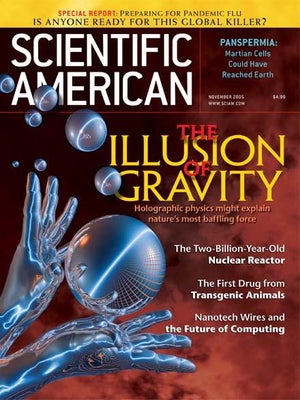
November 1, 2005
The Workings of an Ancient Nuclear Reactor
Two billion years ago parts of an African uranium deposit spontaneously underwent nuclear fission. The details of this remarkable phenomenon are just now becoming clear
If you're enjoying this article, consider supporting our award-winning journalism by subscribing. By purchasing a subscription you are helping to ensure the future of impactful stories about the discoveries and ideas shaping our world today.
In May 1972 a worker at a nuclear fuel-processing plant in France noticed something suspicious. He had been conducting a routine analysis of uranium derived from a seemingly ordinary source of ore. As is the case with all natural uranium, the material under study contained three isotopes--that is to say, three forms with differing atomic masses: uranium 238, the most abundant variety; uranium 234, the rarest; and uranium 235, the isotope that is coveted because it can sustain a nuclear chain reaction. Elsewhere in the earth's crust, on the moon and even in meteorites, uranium 235 atoms make up 0.720 percent of the total. But in these samples, which came from the Oklo deposit in Gabon (a former French colony in west equatorial Africa), uranium 235 constituted just 0.717 percent. That tiny discrepancy was enough to alert French scientists that something strange had happened. Further analyses showed that ore from at least one part of the mine was far short on uranium 235: some 200 kilograms appeared to be missing--enough to make half a dozen or so nuclear bombs.
For weeks, specialists at the French Atomic Energy Commission (CEA) remained perplexed. The answer came only when someone recalled a prediction published 19 years earlier. In 1953 George W. Wetherill of the University of California at Los Angeles and Mark G. Inghram of the University of Chicago pointed out that some uranium deposits might have once operated as natural versions of the nuclear fission reactors that were then becoming popular. Shortly thereafter, Paul K. Kuroda, a chemist from the University of Arkansas, calculated what it would take for a uranium-ore body spontaneously to undergo self-sustained fission. In this process, a stray neutron causes a uranium 235 nucleus to split, which gives off more neutrons, causing others of these atoms to break apart in a nuclear chain reaction.

This article was originally published with the title “ The Workings of an Ancient Nuclear Reactor ” in Scientific American Magazine Vol. 293 No. 5 ( November 2005 )
doi: 10.1038/scientificamerican112005-3d22MmraBruLRjudkRFcAi
Learn and share the most exciting discoveries, innovations and ideas shaping our world today.